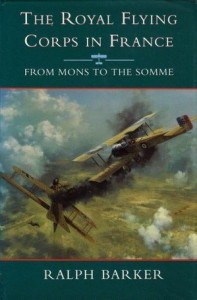A comprensive history of the RFC that never loses sight of the men

I first read the first volume of Ralph Barker’s history of the Royal Flying Corps nearly two decades ago. At the time I thought it was a good book but a little lightweight, likely because at that time I was hoping to find Barker's coverage more detailed than was the case. This was probably a factor in why I did not follow it up by reading the second volume, and as the years passed I felt as though I couldn’t without reading the first volume again. When I finally had the opportunity to do so, it gave me an opportunity to reassess the book and to appreciate just how much my initial judgment was in error.
What Ralph Barker provides in this book is a history of the Royal Flying Corps operations in France from their initial deployment in France to the battle of the Somme. While this may seem obvious from its subtitle, it means that the task the author sets out for himself is to cover a topic of considerable scope. At the start of the war, the RFC was a young branch of the army promising expanded opportunities to scout the battlefield. While their role was appreciated by many of the generals, it was on the pilots to get their planes across the English Channel to join up with the British Expeditionary Force (BEF) – a greater challenge than might be appreciated today, as Louis Blériot’s history-making flight demonstrating that it was possible was just five years beforehand. In this respect it was a testament to the men that most of them crossed over successfully.
These pilots were soon employed in the vital task of supplying intelligence on the movement of German forces. Here Barker might have elaborated a little further on the task and the role that it played in the BEF’s operations. What Barker makes clear, though, is that the men chafed at their limits. As a group of adventurous individuals eager to press against the boundaries before them, they wanted to make a greater contribution to operations, by attacking the enemy on the ground and in the air. Here the main obstacle was a technological one, as the planes at this stage of the war often could bear little more than the weight of the pilot and his observer. Even as the pilots innovated and were provided with better planes, they were often frustrated by the challenge of firing their weapons through their propellers of their tractor-engine planes. That the men persevered, often by taking up hand-held firearms, flying inferior pusher models, or rigging workarounds, was a testament to their aggression and commitment to doing more.
Equaling the pilots in their determination to proving the usefulness of the nascent air arm were their commanders. Here the key figure was Hugh “Boom” Trenchard. Though not the first commander of the RFC forces in France, upon taking up the post in August 1915 he quickly defined the role with his assertive personality. Enjoying a good working relationship with Douglas Haig, the commander of the BEF, he was determined to demonstrate the RFC’s utility no matter what the cost. Barker portrays this as a reflection of Trenchard appreciation that the RFC’s primary role in support of the army’s ground operations. Doing this required undertaking dangerous missions and an operational tempo which pushed the men to their limits and often led to their sacrifice. Though Trenchard regretted their loss, he knew he could do no less if he was to show that the RFC was doing as much as the soldiers in the trenches.
Thanks to such efforts, by the summer of 1916 the RFC was a vital part of the BEF, engaging in missions ranging from scouting to dropping spies behind enemy lines. Barker does an impressive job of covering the full scope of the RFC’s activities, which he does without losing sight of them men who performed them. For all of his coverage of the RFC as a unit, it is these men and their individual stories which make his book such a readable account of the RFC’s operations on the Western Front. Anyone seeking to learn about the RFC and the role it played in the First World War would be well served to start with this book, thanks to its judicious balance of comprehensiveness and perspective.






